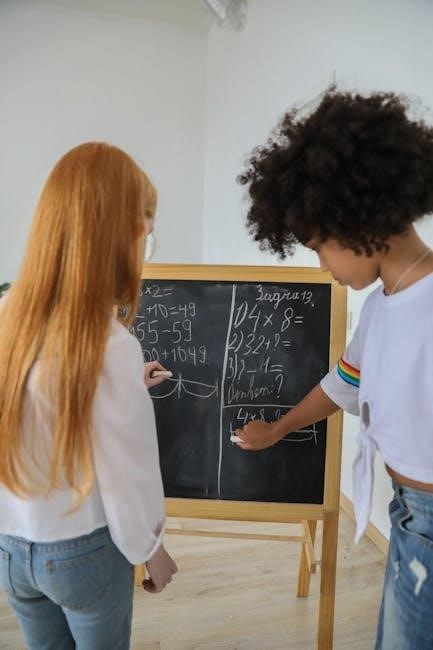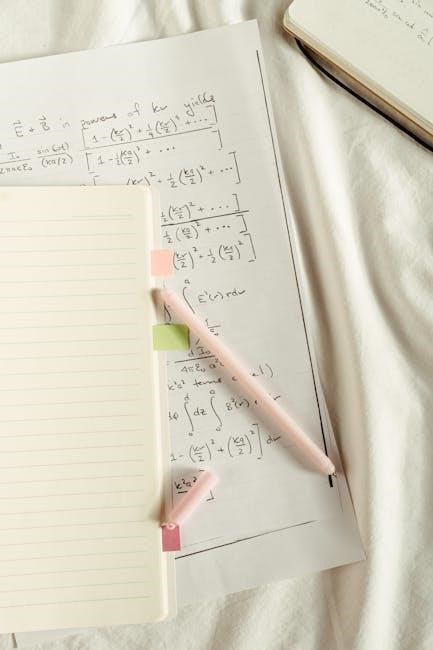Two-step equations are fundamental algebraic problems requiring two operations to isolate the variable. They involve reversing addition/subtraction and multiplication/division. Essential for building algebraic skills, these equations appear in various real-world applications and are widely used in educational resources like Kuta Software and WorksheetWorks.com.
Definition of 2-Step Equations
A two-step equation is an algebraic equation that requires two distinct operations to solve for the variable. These equations typically involve a combination of addition/subtraction and multiplication/division. For example, an equation like 3x + 6 = 12 requires first subtracting 6 and then dividing by 3 to find the value of x. Two-step equations can involve integers, fractions, or decimals, making them versatile for various mathematical scenarios. They are a fundamental concept in algebra, as they introduce students to the idea of reversing operations to isolate a variable. These equations are widely used in educational materials, such as worksheets from Kuta Software and WorksheetWorks.com, to help students build problem-solving skills. Understanding two-step equations is crucial for progressing to more complex algebraic problems.

Importance of Solving 2-Step Equations
Solving two-step equations is crucial for developing foundational algebraic skills. These equations teach the process of reversing operations to isolate a variable, a concept essential for more complex mathematical problems. They are widely applicable in real-world scenarios, such as financial calculations, scientific experiments, and everyday budgeting. Mastering two-step equations enhances problem-solving abilities and logical thinking, which are valuable in various academic and professional settings. Additionally, they serve as a stepping stone to more advanced algebraic concepts, making them a fundamental part of mathematics education. The ability to solve these equations efficiently also improves critical thinking and attention to detail, reducing errors in more complex mathematical tasks.
Key Concepts and Terminology
Mastering two-step equations involves understanding key concepts such as inverse operations, order of operations, and the balance method. Inverse operations, like addition and subtraction or multiplication and division, are used to isolate the variable. The order of operations ensures that operations are performed correctly, while the balance method maintains equality by applying the same operation to both sides. Terminology includes terms like “coefficient,” “constant,” and “variable,” which are essential for interpreting and solving equations. Additionally, understanding how to apply these concepts to different types of numbers, such as integers, fractions, and decimals, is vital for comprehensive mastery. These foundational skills are reinforced through practice with worksheets and problem sets available in resources like Kuta Software and WorksheetWorks.com, helping learners build confidence and proficiency.

The Solving Process
Solving two-step equations involves two main steps: first, undoing addition or subtraction, and then reversing multiplication or division. This structured approach ensures the equation remains balanced and the variable is isolated effectively.
Step 1: Undo Addition or Subtraction

The first step in solving a two-step equation is to eliminate any constants added or subtracted from the variable term. This is done by performing the inverse operation. For example, if the equation is 3y + 6 = 12, subtract 6 from both sides to isolate the term with the variable. Similarly, if the equation is 10 ⎯ 3v = 25, subtract 10 from both sides. These operations ensure the equation remains balanced and simplifies it for the next step. Properly undoing addition or subtraction sets the stage for isolating the variable through the second step of reversing multiplication or division.
Step 2: Undo Multiplication or Division
The second step involves isolating the variable by reversing any multiplication or division. For instance, in the equation 2x + 3 = 11, after undoing addition by subtracting 3, the equation becomes 2x = 8. To solve for x, divide both sides by 2, yielding x = 4. Similarly, in 9x ⎯ 7 = 7, after adding 7 to both sides, the equation simplifies to 9x = 14. Dividing both sides by 9 gives x = 14/9. This step ensures the variable is isolated, providing a clear solution. Properly applying the inverse operations for multiplication or division is critical for accuracy. Always check your solution by substituting it back into the original equation to verify correctness. This methodical approach ensures reliable results in solving two-step equations.
Common Strategies for Solving
Effective strategies for solving two-step equations include following a consistent step-by-step approach. First, identify and undo any addition or subtraction, then address multiplication or division. Using inverse operations is crucial—addition and subtraction are inverses, as are multiplication and division. It’s important to apply these operations to both sides of the equation to maintain balance. Another strategy is to simplify the equation gradually, ensuring each step is clear. Checking solutions by substituting them back into the original equation helps verify accuracy. Additionally, breaking down complex problems into smaller steps can enhance understanding. Utilizing resources like Kuta Software and WorksheetWorks.com provides structured practice. Consistent practice and attention to detail are key to mastering two-step equations. These strategies build a strong foundation for solving more complex algebraic problems in the future. Always approach each equation systematically to achieve accurate solutions. Regular practice reinforces these methods, ensuring proficiency.
Checking Your Solution
Checking your solution is a critical step in verifying the accuracy of your answer. After solving a two-step equation, substitute the value back into the original equation to ensure both sides are equal. For example, if you found that x = 3, replace x with 3 in the original equation and simplify. If both sides match, your solution is correct. This method confirms that the operations performed were accurate and that no mistakes were made during the solving process. Regularly checking solutions helps build confidence and identifies any errors early. It is a good practice to make this a routine part of your problem-solving workflow. By doing so, you can ensure the reliability of your answers and improve your overall understanding of two-step equations. This step is emphasized in educational resources like WorksheetWorks.com and Kuta Software, highlighting its importance. Always verify your solutions to maintain accuracy and precision in your work. This habit will serve you well in more complex mathematical challenges. Through consistent verification, you can refine your skills and achieve consistent success in solving two-step equations.

Examples of 2-Step Equations
Examples of 2-step equations illustrate various problem types, including integers, fractions, decimals, and mixed numbers. These exercises help students master equation solving through thorough practice.
Equations with Integers
Equations with integers are a foundational type of 2-step equation, involving whole numbers. Examples include 6a ─ 4 = 2 and 9x + 7 = 7. These problems require reversing operations like addition, subtraction, multiplication, or division. For instance, solving 3y + 6 = 12 involves subtracting 6 and then dividing by 3 to find y = 2. Similarly, 10 ⎯ 3v = 25 requires adding 10 and then dividing by 3 to find v = 5. These equations are essential for developing algebraic skills and are commonly found in educational resources like Kuta Software and WorksheetWorks.com. They provide a clear structure for understanding how to isolate variables in more complex scenarios, making them a crucial step in mastering algebraic problem-solving.
Equations with Fractions
Equations with fractions introduce an additional layer of complexity in 2-step problems. Examples include 12 ─ 5k = 14 or 7k ⎯ 14 = 42. Solving these requires careful handling of fractional coefficients and constants. For instance, in 12 ⎯ 5k = 14, subtract 12 from both sides to isolate the term with the variable, resulting in -5k = 2. Then, divide both sides by -5 to find k = - rac{2}{5}. These equations often appear in mixed-number formats, such as rac{3g}{5} + 17 = 32, where isolating the fraction is key. Worksheets from Kuta Software and WorksheetWorks.com provide extensive practice for these scenarios. Mastering fractional equations enhances problem-solving skills and prepares students for more advanced algebraic concepts. Regular practice helps build confidence and accuracy when dealing with fractions in 2-step equations.
Equations with Decimals
Equations with decimals add complexity due to their precise nature. For example, 2.5x + 3.8 = 7.2 requires isolating the decimal term. Subtracting 3.8 from both sides gives 2.5x = 3.4, then dividing by 2.5 yields x = 1.36. Another example is 4.2y ⎯ 1.9 = 9.5, where adding 1.9 to both sides results in 4.2y = 11.4, and dividing by 4.2 gives y ≈ 2.71. These equations often appear in financial and scientific contexts, making them practical for real-world applications. Worksheets from Kuta Software and WorksheetWorks.com offer comprehensive drills, ensuring students grasp these essential skills. Regular practice with decimal equations enhances numerical accuracy and problem-solving abilities, crucial for advanced mathematics and everyday calculations.
Mixed Equations (Integers, Fractions, Decimals)
Mixed equations combine integers, fractions, and decimals, offering varied challenges. For instance, solve 3.5x + 2 = 5.5 by subtracting 2 to get 3.5x = 3.5, then dividing by 3.5 for x = 1. Another example is 4y ⎯ 1.25 = 2.75, where adding 1.25 yields 4y = 4, so y = 1. These equations enhance problem-solving versatility and are featured in resources like Kuta Software and WorksheetWorks.com. They simulate real-life scenarios, such as budgeting, where mixed numbers are common. Regular practice with these equations improves adaptability in handling diverse numerical formats, a critical skill for advanced math and practical applications. Worksheets often include ten problems for thorough practice, ensuring mastery of mixed equations.

Worksheets and Practice Materials
Extensive 2-step equations PDF worksheets are available, featuring problems with integers, fractions, and decimals. Kuta Software and WorksheetWorks.com offer printable resources, including answer keys for self-checking and custom worksheet creation options.

PDF Worksheets for 2-Step Equations
PDF worksheets for 2-step equations are widely available online, offering comprehensive practice for students; These resources, such as those from Kuta Software and WorksheetWorks.com, provide a variety of problems involving integers, fractions, and decimals; Many worksheets include answer keys, enabling self-checking and immediate feedback; They are designed to cater to different skill levels, from basic to advanced, ensuring thorough mastery of two-step equations. Additionally, some PDFs incorporate visual models and real-world applications, making learning engaging and practical. Teachers and students can easily download and print these worksheets, making them a convenient tool for classroom or homework use. Regular practice with these materials helps build confidence and fluency in solving algebraic equations.
Worksheets with Answers
Worksheets with answers are invaluable tools for mastering 2-step equations, providing immediate feedback and reinforcing understanding. Many PDF resources, such as those from Kuta Software and WorksheetWorks.com, include answer keys, allowing students to verify their solutions. These worksheets often feature step-by-step solutions, helping learners identify and correct mistakes. They cater to various skill levels, offering problems with integers, fractions, and decimals. Answers are typically provided on separate pages or at the end of the document, ensuring that students can check their work without spoilers. Some worksheets also include color-coding or annotations to guide learners through complex problems. With these resources, students can practice independently, building confidence and fluency in solving 2-step equations. Teachers also benefit, as answer keys streamline grading and progress tracking.
Worksheets with Integers, Fractions, and Decimals
Worksheets featuring integers, fractions, and decimals provide comprehensive practice for solving 2-step equations. These resources cater to diverse skill levels, ensuring learners can gradually master more complex problems. Many PDF worksheets include mixed equations, such as solving for variables in expressions like 3y + 6 = 12 or 2x ─ 8 = 16. Fractions and decimals add an extra layer of challenge, helping students improve their arithmetic skills. For example, equations like 5k ─ 2.4 = 3.2 or 7m/4 = 14 require precise calculation. These worksheets often include step-by-step solutions or answer keys, allowing students to verify their work. Some resources also incorporate color-coding or annotations to guide learners through problem-solving. By practicing with integers, fractions, and decimals, students gain fluency and confidence in tackling a wide range of algebraic challenges, preparing them for more advanced math concepts.
Creating Your Own Worksheets
Creating custom worksheets for 2-step equations allows educators and learners to tailor practice to specific needs. Tools like Kuta Software and Infinite Pre-Algebra enable users to generate PDF worksheets with varied problem sets. By selecting operations, number types, and difficulty levels, teachers can design targeted exercises. For instance, worksheets can focus on integers, fractions, or decimals, or mix these for comprehensive practice. Some software also permits adding visual elements, such as part-whole models, to aid understanding. Additionally, creating worksheets with answer keys streamlines grading and self-assessment. This customization ensures that learners can practice efficiently, addressing gaps and reinforcing strengths. With the flexibility to adapt content, creating one’s own worksheets enhances the learning experience, making it both personalized and effective for mastering 2-step equations.

Common Mistakes and Tips
Common errors include reversing operations incorrectly and mishandling negative signs. Tips suggest showing all steps, checking solutions by substitution, and practicing consistently to build proficiency and accuracy in solving equations.
Common Errors in Solving 2-Step Equations
One of the most frequent mistakes students make is incorrectly reversing the order of operations. For instance, subtracting before dividing or adding instead of multiplying can lead to incorrect solutions. Another common error is mishandling negative signs, especially when dividing or multiplying by a negative coefficient. Additionally, students often forget to apply operations to both sides of the equation consistently, which disrupts the balance and leads to wrong answers. Misinterpreting the equation structure, such as identifying the correct operation to undo first, is another pitfall. Lastly, neglecting to check the solution by substituting it back into the original equation is a mistake that prevents students from verifying their work. These errors highlight the importance of careful step-by-step execution and thorough checking.
Tips for Avoiding Mistakes
To avoid mistakes when solving two-step equations, it’s crucial to approach each problem methodically. Always begin by identifying and reversing the operations in the correct order, starting with addition/subtraction and then addressing multiplication/division. Writing down each step clearly helps prevent errors and ensures that operations are applied consistently to both sides of the equation. Pay special attention to negative signs and coefficients, as mishandling them can lead to incorrect solutions. Another key strategy is to check your work by substituting the found value back into the original equation to verify its accuracy. Using resources like Kuta Software or WorksheetWorks.com can also provide guided practice and reinforce proper techniques. By being meticulous and systematic, students can significantly reduce errors and build confidence in their problem-solving abilities.
Best Practices for Showing Work
When solving two-step equations, clear and organized work is essential for understanding and grading. Begin by rewriting the original equation to ensure clarity. Next, perform each operation step-by-step, showing the reversal of addition/subtraction first, followed by multiplication/division. Use arrows or annotations to explain each step, making it easy to follow the logic. Avoid skipping steps, as this can lead to confusion and potential errors. After finding the solution, substitute the value back into the original equation to verify its correctness. This verification process reinforces understanding and ensures accuracy. Properly labeling each step and maintaining a neat, legible format are also critical. By adhering to these practices, students can develop a systematic approach to problem-solving, which is highly recommended in educational resources like Kuta Software and WorksheetWorks.com.

Real-World Applications
Two-step equations are essential in everyday life, financial planning, and scientific calculations. They help solve problems like budgeting, mixing solutions, and calculating distances, making them invaluable in practical scenarios.
Using 2-Step Equations in Everyday Life
Two-step equations are practical tools for everyday problem-solving. For instance, calculating the total cost of groceries with discounts or determining the correct change involves reversing operations like addition and multiplication. These equations also help in cooking, where adjusting ingredient quantities requires scaling recipes up or down. Additionally, managing personal finances, such as budgeting expenses and savings, often relies on solving two-step equations. They are used in mixed solutions, like determining the right proportions of chemicals or medications. Even in fitness, calculating heart rate zones or workout durations can involve two-step equations. Their versatility makes them indispensable in various daily tasks, reinforcing the importance of mastering this algebraic skill.
Examples from Science and Engineering
In science and engineering, two-step equations are essential for solving real-world problems. For instance, in physics, calculating velocity involves reversing addition and multiplication, such as when determining initial speed from distance and acceleration. Chemistry uses these equations to balance reactions and calculate concentrations. Engineers apply them to design structures, ensuring materials meet safety standards by solving for stress or load capacities. Environmental science relies on two-step equations to model population growth or calculate carbon emissions. These practical applications highlight the importance of understanding how to isolate variables and reverse operations, making two-step equations a cornerstone of scientific and engineering problem-solving.
Financial Applications of 2-Step Equations
In finance, two-step equations are crucial for making informed decisions. They are used to calculate interest rates, where the principal and time are known but the rate is unknown. For example, determining the interest rate on a loan involves reversing addition and multiplication to isolate the rate. Budgeting and investment planning also rely on these equations to project future values or determine required contributions. In inflation adjustments, two-step equations help calculate real interest rates by factoring in inflation. Additionally, tax calculations often involve solving for variables like taxable income or deductions. These applications show how two-step equations provide practical tools for managing personal and organizational finances effectively, ensuring accurate and informed decision-making in the financial sector.
Two-step equations are essential algebraic tools with wide-ranging applications. From everyday problem-solving to financial planning, mastering these equations enhances mathematical proficiency and practical decision-making skills, proving their lasting value.

Two-step equations are algebraic problems requiring two operations to solve, such as reversing addition/subtraction and multiplication/division; They are fundamental for building algebraic skills and appear in real-world applications like finance and science. Resources like Kuta Software and WorksheetWorks.com provide extensive practice materials. Key steps include isolating the variable and checking solutions. Common mistakes involve incorrect operation reversal and miscalculations. Properly showing work enhances understanding and accuracy. Mastering these equations is crucial for advanced math and problem-solving abilities, proving their lasting educational value. Regular practice with worksheets and real-world examples reinforces proficiency, making them indispensable in algebraic learning and practical problem-solving scenarios.
Final Thoughts on Mastering 2-Step Equations
Mastering two-step equations is a foundational skill in algebra, essential for problem-solving in various academic and real-world contexts. These equations build upon basic algebraic concepts, requiring the reversal of operations like addition/subtraction and multiplication/division. Consistent practice with worksheets from resources like Kuta Software and WorksheetWorks.com can significantly improve proficiency. Understanding how to isolate variables and check solutions ensures accuracy. Common mistakes, such as reversing operations incorrectly, can be avoided by showing detailed work. Encouraging real-world applications and practical examples helps reinforce learning. With persistence and the right tools, anyone can confidently master two-step equations, paving the way for more complex mathematical challenges.
